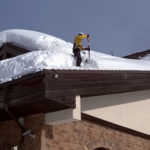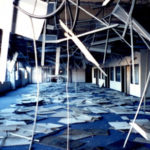We received a request from Martin H., one of our blog readers, to discuss the method for determining roof wind pressures on an open front agricultural building. The inquiry was regarding clarification on analyzing the roof pressure when a combined external and interior pressure exists and whether these are additive.
As can be seen in the above illustrations, the net design pressure on the roof is the sum of the uplift on the exterior surface and the uplift on the interior surface from any internal pressure. ASCE 7 provides a method for determining this pressure. Specifically, ASCE 7-10 will be used for the remainder of this post. Assuming the three remaining sides of the open front structure are walls without openings, the building will be classified as partially enclosed by the definitions of Section 26.2.
ASCE 7-10 provides for two methods for determining the Main Wind Force Resisting System (MWFRS) wind loads for partially enclosed buildings, the Directional Procedure in Chapter 27, and the Envelope Procedure in Chapter 28.
When using the Directional Procedure, the net wind load is calculated using the following equation:
P = qGCp – qi(GCpi)
When using the Envelope Procedure, the net wind load is calculated using the following equation:
P = qh[(GCpf) – (GCpi)]
In each of these equations, the first portion determines the pressure on the exterior surface, and the second portion determines the pressure on the interior surface. So the variable for calculating the internal pressure is the internal pressure coefficient GCpi.
The internal pressure coefficient is provided in Table 26.11-1 based on three different categories of building enclosure.
Enclosure Classification | (GCpi) |
| Open Buildings | 0.00 |
| Partially Enclosed Buildings | +0.55 -0.55 |
| Enclosed Buildings | +0.18 -0.18 |
Table 26.11-1
In the case of an open front structure, it is assumed that the partially enclosed internal pressure coefficient must be used. This coefficient is 3x greater than when the building envelope is classified as enclosed. Use of this higher coefficient in the design will account for the interior pressure on the underside of the roof combined with the exterior pressure.
MWFRS versus C&C
Another somewhat related question: to what level loads should the roof anchorage forces be calculated, MWFRS or C&C (Component and Cladding)? I have often been asked this question, and wrote a Technical Note published by CFSEI (Cold-Formed Steel Engineers Institute) in July 2009.
What are your thoughts?
– Sam
What are your thoughts? Visit the blog and leave a comment!







And if the structure is a roof supported on exposed columns without any enclosure walls, say either moment frames or cantilevered columns, then how is the horizontal MWFRS load determined?
Steve Perlof
There is a section in ASCE-7 for open structures. In the 05 edition figures 6-18A & 6-18B apply for mono-sloped and gable roof respectively.
I would design the roof-to-wall and the wall-to-foundation anchorage for MWFR forces. As I understand it the C&C forces try to account for locally higher wind forces over small areas, while the MWFR forces are a more realistic value for overall average wind force on a structure.
With regard to a totally open-walled structure mentioned by Steve, the MWFR forces on the roof would be used to determine the resultant horizontal & vertical force components applied to the tops of the columns.
This would depend on the size of the structure. 700 sq. ft. of tributary area is generally the dividing line between C&C and MWFRS.
The individual truss connections would generally be C&C and the building frame would generally be MWFRS. In some situations both cases need to be investigated.
Should the designer use the partially open or completely open case when there is only one wall?
You should use partially enclosed (or partially open for the optimist?), since there will be a positive pressure built up in the structure due to the blockage from the wall.
I am continually amazed with the quality of your cotnent! Would you do me the honor or writing a “guest blog” post more the GDI blog?
Another question related to this issue is whether or not the internal pressure developed on the leeward wall adds to the overall horizontal ground shear. Normally the internal wall pressures cancel out in calculating ground shear, but on 3-sided buildings, this is not so clear. ASCE 7 is frustratingly vague on this question. Conservatism tells you to include the internal pressure in the calculations, but this can lead to excessively large bracing and anchorage in the sidewalls. Any thoughts on this would be appreciated.
what if i would like to design a multipurpose hall which is open on the left and right sides and in front but totally enclosed on the rear. is this multipurpose hall that im going to design is considered as partially enclosed building or an open building.?
If I understand you question correctly you are basically designing a box with three sides open.
Determination of a building’s Enclosure Classification in ASCE 7-10 is specified in Chapter 26 in the Definitions.
Buildings are classified as either Enclosed, Partially Enclosed, or Open.
“Building, Open” is defined as “A building having each wall at least 80% open.” Since one wall in your building is not open, I don’t believe this definition applies.
“Building, Partially Enclosed” is defined as “A building that complies with both of the following conditions:
1. The total area of openings in a wall that receives positive external pressure exceeds the sum of the areas of openings in the balance of the building envelope (walls and roof) by more than 10 percent.
2. The total area of openings in a wall that receives positive external pressure exceeds 4 ft2 or 1% of the area of that wall, whichever is smaller, and the percentage of openings in the balance of the building envelope does not exceed 20%”
So without knowing the exact configuration of your building I see three cases that we need to analyze.
1. Approximately square.
2. Closed side on very short wall
3. Closed side on long wall.
Case 1. If we say the top wall is the wall that receives positive external pressure (wind is blowing from top to bottom), then the area of that wall does NOT exceed the sum of areas of openings in the other walls. So this would not be Partially Enclosed.
Case 2. Again, if the top wall is the wall that receives positive external pressure, then clearly that wall does NOT exceed the sum areas in openings in the other walls. So this configuration would not be considered partially enclosed either.
Case 3. This is where it can get tricky. If we look at the top wall as the wall that receives positive internal pressure, and if the length of the longer wall is more than 1.1 times the total the length of the two vertical walls, then the area of openings in the top wall does exceed the sum of openings in the rest of the building by more than 10%. Second, IF the area of the two side walls does not exceed 20% of the total area of those two walls and the solid wall, then it would also meet the second condition. In that rare case, it would be considered PARTIALLY ENCLOSED.
Finally, “Building, Enclosed” is defined as “A building that does not comply with the requirements for open or partially enclosed buildings.”
So except for the third case above where the closed wall is very long compared to the adjacent walls, I believe your building would be classified as Enclosed.
This is also based on the assumption that your enclosed wall is 100% enclosed.
Please note: This reply is incomplete because our diagrams can’t be uploaded in the comments section. We will email you the complete response.